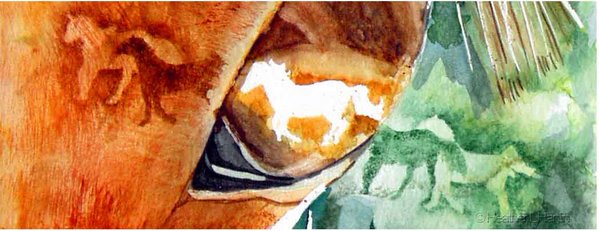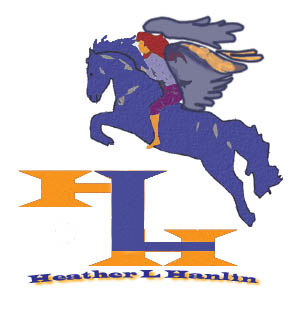Lunch was on a hill of black rock overlooking a valley. There were petroglyphs on the rock. One looked like an alien with three legs wearing a space helmet. We’d seen some other with squiggly figures on an outcropping that seemed to also have a mountain lion den. Tex was about 16 hands (over 5 feet at the shoulder), which gets much taller after lunch when you’ve been in the saddle all morning. I was maneuvering him to a rock for mounting when I stepped off and went sprawling in the dirt. My knee stung and I figured I’d bumped it on a rock. It wasn’t until I was in the saddle that I noticed there was a hole in my pants that was starting to turn red. I dismounted so I could take off my gaiter and roll up my pant leg. I called for a band-aid and Kaylin, another wrangler, was right there with one. I was a little worried my knee might swell in the night—but the bump stayed on the surface.

June 8, 2009
Ivana came in last night. Two other wranglers left to go take care of a horse at the pack station, which is across the valley. She’s been here for ten years or so, studying the mustangs. I thought Craig knew an incredible amount about tracking and finding the horses in all that wild open country. But Ivana made him look like a novice. She was very no nonsense with blond hair swept back and an eastern European accent. She showed us a horse skeleton in the lower Pizona spring area. All part of the cycle.
She talked about which bands she’d seen where, and where she thought horses might be today and then we set off in our silent pack string. We rode through an old Mustanger trap. Old fence was still there along the canyon walls and the logs used as a gate were piled under a tree.
Round about lunchtime she spotted a band of five horses. We’d gotten much better at our dismount, tie up and sneak through the bushes routine. The horses were aware of our presence and were about a quarter of a mile off. The stallion trotted out towards us about half that distance—just to see what we were. Then he trotted back and the herd slowly moved along the flat and over a low hill. So we got to watch them for a long time. At first Ivana thought it was a bachelor herd: a group of young stallions that will band together after being expelled by their parents. But after watching the behavior she decided it was a stallion with mares. A bachelor group will “elect” a nominal leader—but all of them would exhibit curiosity about us and approach somewhat when they have no foals or mares to protect. In this case the stallion came out alone and went back lowering his head and laying back his ears at the lead mare to give her the signal to move on.
Later around the campfire Ivana was explaining this exchange and how important the horse’s ears are in communication. She gave a detailed description of different horse expressions and then she said, as matter of fact as the rest of it, “when they put their heads together they are communicating telepathically.” I sat there a little stunned.
One man asked, “How can you prove that?”
Ivana said, “I’ve done it with them.”
Well how can you argue with that? I’ve certainly had moments with my horses that felt telepathic. And I’ve been around alternative horse practitioners that it wouldn’t have surprised me a bit if they said this. But to have Ivana say it with her scientific air and eastern European accent was a bit of a shock.

June 9, 2009
This morning we packed our bags and placed our dunnage on the tarp to be loaded on the truck and then got on our horses. Ivana took us out looking for the power line herd. But when we got in the hills near the power lines, before they run through Adobe Valley, there was little sign of horses. The tracks I saw looked old to me and Ivana said something about the horses not having passed over the ridge in at least a day. She also said the tracks she saw were heading the opposite direction. I guess they’d gone over the ridge but not come back yet.
So she showed us another skeleton. This one had been out for over a year and the scavengers had scattered it quite a bit. The skull was up under a tree while the pelvis and half the jawbone was out in the open. The teeth on the skull and jaw indicated that the horse was quite old when it died, and because it didn’t have the wolf teeth that it was a mare. If the wild horses survive to adulthood they then live quite long lives. About 60% of the foals are killed by mountain lions.
We then saw some horses way across the valley. Again little tiny dots I could barely distinguish as having a horse shape with my binoculars. But at least we’d spotted horses. We could say we saw horses every day.
We rode parallel to the ridge for a while and then stopped. Ivana crept ahead to the edge of the ridge and then motioned us forward. Down below in the River Springs was a herd of 18 horses. We got our lunches and sat and watched them. Three young stallions had a play fight, rearing up and pawing at each other. Some of the horses were taking naps others were grazing. There were also two horses in the River Springs area that were far away from the main group. We were able to watch this herd as we rode back to our parked cars. The herd moved out into the greener area around the springs and came upon one of the lone horses. There was some squealing we could hear and the stallion reared up and then turned and kicked his heels at the lone horse, which then turned and moved away. I guess that lone horse was one of the younger stallions that’d been turned out and was still following the herd at a distance.
It was disappointing to come around the bend and see our cars glinting in the dusty air. The trip was over. But my camera and memory banks were full.

June 10, 2009The passes were open and I had a lovely drive home through Yosemite National Park. Stunning scenery so different from the high desert I’d been in and the bay flats I returned to.

More photos are on my
Picasa Album.













 More photos are on my Picasa Album.
More photos are on my Picasa Album. The subject is less about Adapting (although the sea and the shore are constantly adapting to each other as the tides come and go.) But the process of this one does talk about adapting. I didn't do last week's prompt--and I could feel myself veering away from this one as well. A slippery slope of adjusting to not doing art. So rather than start with a thought, that I then translate into an image, and then plan on the paper as a drawing, etc. I started with the word and how it makes me feel. I chose a watercolor crayon from my box at random and with my eyes closed sketched a few lines. When I opened my eyes the wave was there. So from there I decided it was a shore scene. Which I guess does talk about me and my process of adapting to my new home nearer the ocean when I've been land locked the rest of my life.
The subject is less about Adapting (although the sea and the shore are constantly adapting to each other as the tides come and go.) But the process of this one does talk about adapting. I didn't do last week's prompt--and I could feel myself veering away from this one as well. A slippery slope of adjusting to not doing art. So rather than start with a thought, that I then translate into an image, and then plan on the paper as a drawing, etc. I started with the word and how it makes me feel. I chose a watercolor crayon from my box at random and with my eyes closed sketched a few lines. When I opened my eyes the wave was there. So from there I decided it was a shore scene. Which I guess does talk about me and my process of adapting to my new home nearer the ocean when I've been land locked the rest of my life.